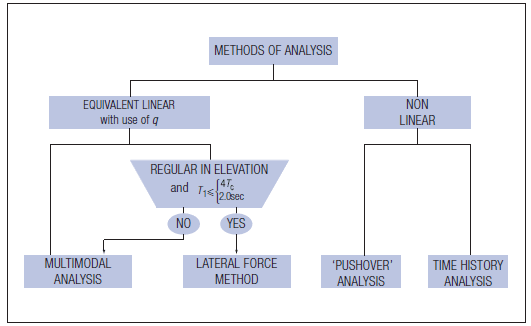My answer is based on definitions given in Eurocode 8 (EN1998-1:2004)"Design of structures for earthquake resistance". You may check it for your reference.
Generally, analysis can be either Linear or Nonlinear. For the linear analysis, there are two methods: Equivalent Lateral Force and Response Spectrum Analysis. For the nonlinear part, it's either Pushover Analysis (PA), or Time History Analysis (THA). Let's look a bit deeper into the ones' in your question.
*The equivalent lateral procedure (also named seismic coefficient method) from its name, we basically use the static load equivalent to dynamic one from an earthquake. This method accounts for the total base shear for the building under seismic loading determined by using an empirically calculated Time period, and then distributed over the stories as lateral load proportional to an assumed 'mode shape'. Thus the EC8 limits a time period condition in order to analyze with this method. According to clause 4.3.3.2.1 of EC8, I quote:
- "This type of analysis may be applied to buildings whose response is not significantly affected by contributions from modes of vibration higher than the fundamental mode in each principal direction."
This requirement is deemed to be achieved if the following two conditions are met:
1-the fundamental periods of vibration in the two main directions which are smaller than 2.0 sec or 4*Tc (Tc is the upper limit spectral parameter according to ground type, Table 3.2)
2-Elevation regularity criteria (4.2.3.3) are met.
Otherwise, Response Spectrum Analysis (RSA) can be used.
*Response Spectrum Analysis (RSA): A response spectrum is simply a plot of the peak acceleration of each of a series of hypothetical oscillators of varying natural frequency. that are forced into vibration at its base by the same seismic ground motion record. The RSA calculates maximum response values in each mode of a structure from the spectrum curve and then combine these responses using modal superposition. This is cumbersome using hand calculations, thus softwares are often used.
For the second type you mention, did you mean Time History procedure? Coz I've not heard of method such as "response history". It's either Time History Analysis (THA), or Response Spectrum Analysis (RSA).
If you do not see it, you cannot design it!

